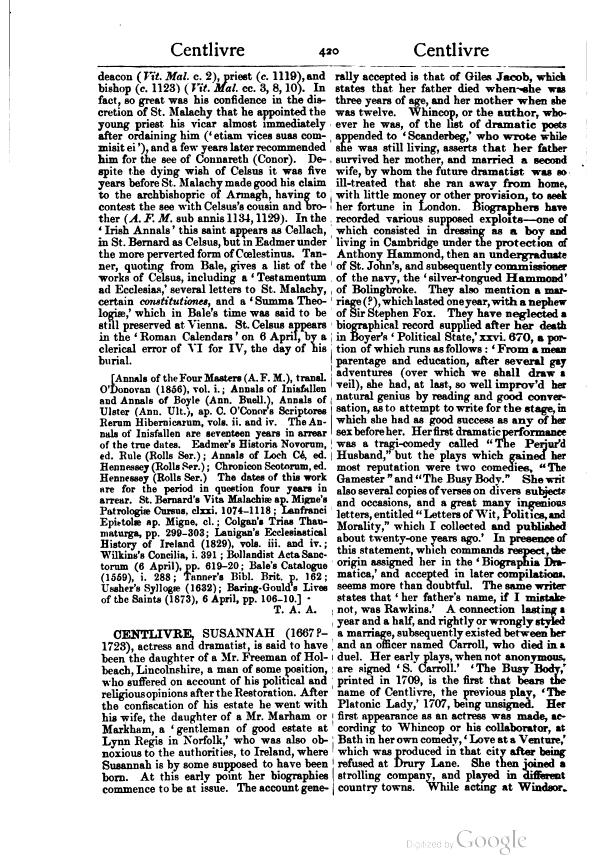deacon (Vit. Mal. c. 2), priest (c 1119), and bishop (c. 1123) (Vit. Mal. cc. 3, 8, 10). In fact, so great was his confidence in the discretion of St. Malachy that he appointed the young priest his vicar almost immediately after ordaining him (‘etiam vices suas commisit ei’), and a few years later recommended him for the see of Connareth (Conor). Despite the dying wish of Celsus it was five years before St. Malachy made good his claim to the archbishopric of Armagh, having to contest the see with Celsus's cousin and brother (A. F. M. sub annis 1134, 1129). In the ‘Irish Annals’ this saint appears as Cellach, in St. Bernard as Celsus, but in Eadmer under the more perverted form of Cœlestinus. Tanner, quoting from Bale, gives a list of the works of Celsus, including a ‘Testamentum ad Ecclesias,’ several letters to St. Malachy, certain constitutiones, and a ‘Summa Theologiæ,’ which in Bale's time was said to be still preserved at Vienna. St. Celsus appears in the ‘Roman Calendars’ on 6 April, by a clerical error of VI for IV, the day of his burial.
[Annals of the Four Masters (A. F. M.), transl. O'Donovan (1856), vol. i.; Annals of Inisfallen and Annals of Boyle (Ann. Buell.), Annals of Ulster (Ann. Ult.), ap. C. O'Conor's Scriptores Rerum Hibernicarum, vols. ii. and iv. The Annals of Inisfallen are seventeen years in arrear of the true dates. Eadmer's Historia Novorum, ed. Rule (Rolls Ser.); Annals of Loch Cé, ed. Hennessey (Rolls Ser.); Chronicon Scotorum, ed. Hennessey (Rolls Ser.). The dates of this work are for the period in question four years in arrear. St. Bernard's Vita Malachiæ ap. Migne's Patrologiæ Cursus, clxxi. 1074–1118; Lanfranci Epistolæ ap. Migne, cl.; Colgan's Trias Thaumaturga, pp. 299–303; Lanigan's Ecclesiastical History of Ireland (1829), vols. iii. and iv.; Wilkins's Concilia, i. 391; Bollandist Acta Sanctorum (6 April), pp. 619–20; Bale's Catalogue (1559), i. 288; Tanner's Bibl. Brit. p. 162; Ussher's Syllogæ (1632); Baring-Gould's Lives of the Saints (1873), 6 April, pp. 106–10.]
CENTLIVRE, SUSANNAH (1667?–1723), actress and dramatist, is said to have been the daughter of a Mr. Freeman of Holbeach, Lincolnshire, a man of some position, who suffered on account of his political and religious opinions after the Restoration. After the confiscation of his estate he went with his wife, the daughter of a Mr. Marham or Markham, a ‘gentleman of good estate at Lynn Regis in Norfolk,’ who was also obnoxious to the authorities, to Ireland, where Susannah is by some supposed to have been born. At this early point her biographies commence to be at issue. The account generally accepted is that of Giles Jacob, which states that her father died when she was three years of age, and her mother when she was twelve. Whincop, or the author, whoever he was, of the list of dramatic poets appended to ‘Scanderbeg,’ who wrote while she was still living, asserts that her father survived her mother, and married a second wife, by whom the future dramatist was so ill-treated that she ran away from home, with little money or other provision, to seek her fortune in London. Biographers have recorded various supposed exploits—one of which consisted in dressing as a boy and living in Cambridge under the protection of Anthony Hammond, then an undergraduate of St. John's, and subsequently commissioner of the navy, the ‘silver-tongued Hammond’ of Bolingbroke. They also mention a marriage (?), which lasted one year, with a nephew of Sir Stephen Fox. They have neglected a biographical record supplied after her death in Boyer's ‘Political State,’ xxvi. 670, a portion of which runs as follows: ‘From a mean parentage and education, after several gay adventures (over which we shall draw a veil), she had, at last, so well improv'd her natural genius by reading and good conversation, as to attempt to write for the stage, in which she had as good success as any of her sex before her. Her first dramatic performance was a tragi-comedy called “The Perjur'd Husband,” but the plays which gained her most reputation were two comedies, “The Gamester” and “The Busy Body.” She writ also several copies of verses on divers subjects and occasions, and a great many ingenious letters, entitled “Letters of Wit, Politics, and Morality,” which I collected and published about twenty-one years ago.’ In presence of this statement, which commands respect, the origin assigned her in the ‘Biographia Dramatica,’ and accepted in later compilations, seems more than doubtful. The same writer states that ‘her father's name, if I mistake not, was Rawkins.’ A connection lasting a year and a half, and rightly or wrongly styled a marriage, subsequently existed between her and an officer named Carroll, who died in a duel. Her early plays, when not anonymous, are signed ‘S. Carroll.’ ‘The Busy Body,’ printed in 1709, is the first that bears the name of Centlivre, the previous play, ‘The Platonic Lady,’ 1707, being unsigned. Her first appearance as an actress was made, according to Whincop or his collaborator, at Bath in her own comedy, ‘Love at a Venture,’ which was produced in that city after being refused at Drury Lane. She then joined a strolling company, and played in different country towns. While acting at Windsor,
